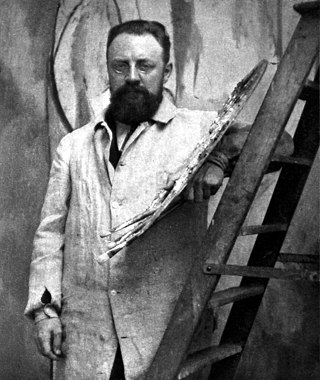
Henri Émile Benoît Matisse was a French visual artist, known for both his use of colour and his fluid and original draughtsmanship. He was a draughtsman, printmaker, and sculptor, but is known primarily as a painter.
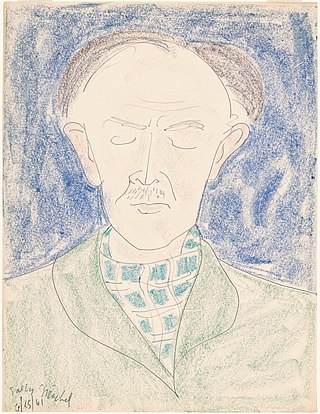
Milton Clark Avery was an American modern painter. Born in Altmar, New York, he moved to Connecticut in 1898 and later to New York City. He was the husband of artist Sally Michel Avery and the father of artist March Avery.

Richard Diebenkorn was an American painter and printmaker. His early work is associated with abstract expressionism and the Bay Area Figurative Movement of the 1950s and 1960s. In the late 1960s he began his extensive series of geometric, lyrical abstract paintings. Known as the Ocean Park paintings, these paintings were instrumental to his achievement of worldwide acclaim. Art critic Michael Kimmelman described Diebenkorn as "one of the premier American painters of the postwar era, whose deeply lyrical abstractions evoked the shimmering light and wide-open spaces of California, where he spent virtually his entire life."

The Kimbell Art Museum in Fort Worth, Texas, hosts an art collection as well as traveling art exhibitions, educational programs and an extensive research library. Its initial artwork came from the private collection of Kay and Velma Kimbell, who also provided funds for a new building to house it.

Paul Rosenberg was a French art dealer. He represented Pablo Picasso, Georges Braque and Henri Matisse. Both Paul and his brother Léonce Rosenberg were among the world's major dealers of modern art.
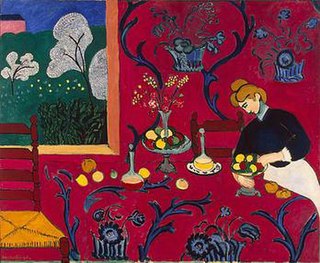
The Dessert: Harmony in Red is a painting by Henri Matisse. Previously titled Harmony in Blue, the painting had a blue background when Matisse first exhibited it in 1908. In 1909, Matisse changed the blue to red, retitling it The Dessert: Harmony in Red.
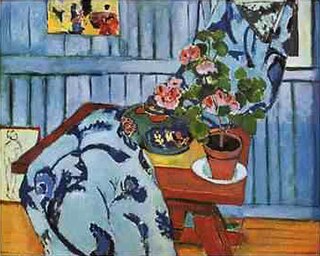
Still Life with Geraniums is a 1910 oil on canvas painting by Henri Matisse.
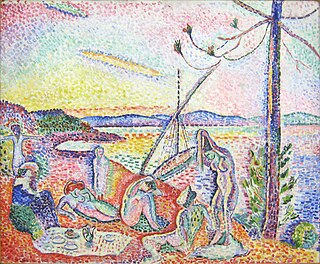
Luxe, Calme et Volupté is a 1904 oil painting by the French artist Henri Matisse. Both foundational in the oeuvre of Matisse and a pivotal work in the history of art, Luxe, Calme et Volupté is considered the starting point of Fauvism. This painting is a dynamic and vibrant work created early on in his career as a painter. It displays an evolution of the Neo-Impressionist style mixed with a new conceptual meaning based in fantasy and leisure that had not been seen in works before.

The Torment of Saint Anthony is a painting by Michelangelo, who painted a close copy of the famous engraving by Martin Schongauer when he was only 12 or 13 years old. Whether the painting by Michelangelo is disputed. This painting is now in the Kimbell Art Museum in Fort Worth, Texas. It shows the common medieval subject, included in the Golden Legend and other sources, of Saint Anthony being assailed in the desert by demons, whose temptations he resisted; the Temptation of St Anthony is the more common name of the subject. But this composition apparently shows a later episode where St Anthony, normally flown about the desert supported by angels, was ambushed in mid-air by devils.

Fauvism is a style of painting and an art movement that emerged in France at the beginning of the 20th century. It was the style of les Fauves, a group of modern artists whose works emphasized painterly qualities and strong colour over the representational or realistic values retained by Impressionism. While Fauvism as a style began around 1904 and continued beyond 1910, the movement as such lasted only a few years, 1905–1908, and had three exhibitions. The leaders of the movement were André Derain and Henri Matisse.

Portrait of Greta Moll is a painting by Henri Matisse from 1908. It is part of the National Gallery collection in London.
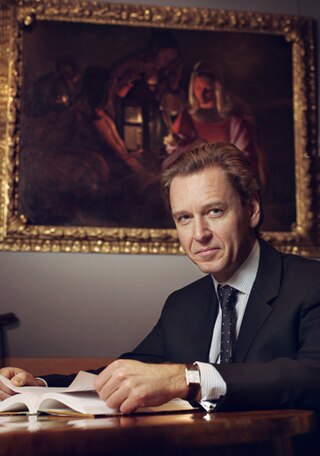
Dr. Timothy Potts is an Australian art historian, archaeologist, and museum director. He became the director of the J. Paul Getty Museum on 1 September 2012.
Frank Richard Perls was a German-born American art dealer who was best known for uncovering a series of fraudulent art works. As an interpreter with the United States Third Army, Perls worked together with Army intelligence officer Martin Dannenberg in April 1945 in the discovery of a copy of the 1935 Nuremberg Laws signed by Adolf Hitler.

The Back Series is a series of four bas-relief sculptures, by Henri Matisse. They are Matisse's largest and most monumental sculptures. The plaster originals are housed in the Musée Matisse in Le Cateau-Cambrésis, France.
Sophie Alexina Victoire Matisse is an American contemporary artist. Matisse initially gained notice for her series of Missing Person paintings, in which she appropriated and embellished upon, or subtracted from, recognizable works from art history.
Joachim Pissarro is an art historian, theoretician, curator, educator, and director of the Hunter College Galleries and Bershad Professor of Art History at Hunter College of the City University of New York. His latest book, authored with art critic David Carrier, is called Wild Art. Pissarro was curator at the Museum of Modern Art's Department of Painting and Sculpture from 2003 to 2007.

Perry Richardson Bass was an American heir, investor, philanthropist and sailor.
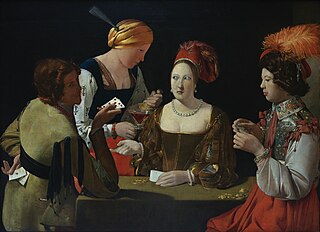
The Card Sharp with the Ace of Diamonds is an oil-on-canvas painting produced c. 1636–1638 by the French artist Georges de La Tour. It is now in the Louvre, which bought it in 1972. Though its commissioner is unknown, it is signed Georgius De La Tour fecit under the card sharp's elbow and in the shadow of the tablecloth.
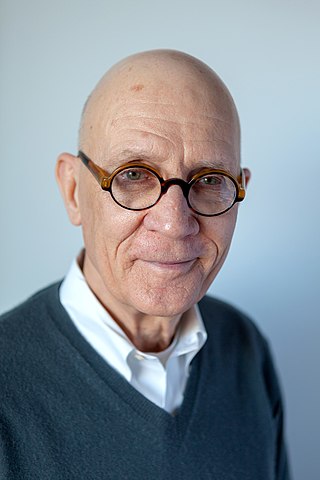
William Bryan Jordan Jr. was an American art historian who facilitated acquisitions, curated exhibitions, and authored publications on Spanish artists and still life paintings, particularly from the Golden Age.
Bathers by a River, also known as Bathers at the River and occasionally referred to as simply Bathers, is a large 1917 oil-on-canvas painting by French artist Henri Matisse. Matisse began painting the canvas in 1909 and finished the painting in the fall of 1917, making it one of three pictures he painted during the Battle of Verdun.
















